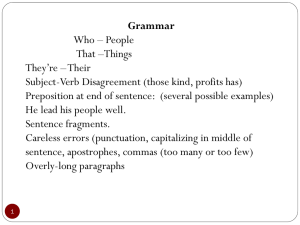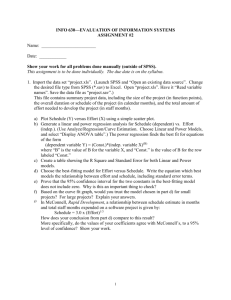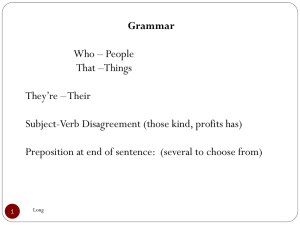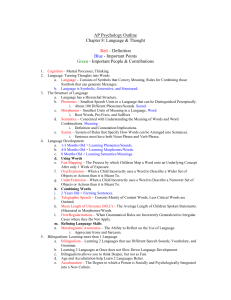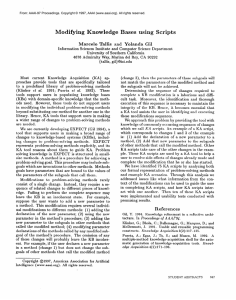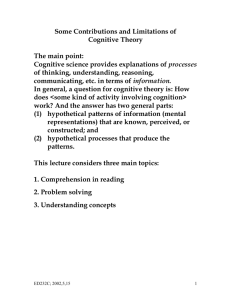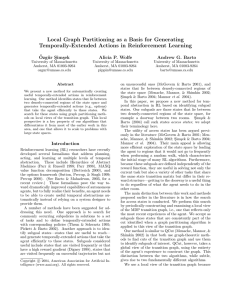A Cost-Directed Planner: Preliminary Report
advertisement
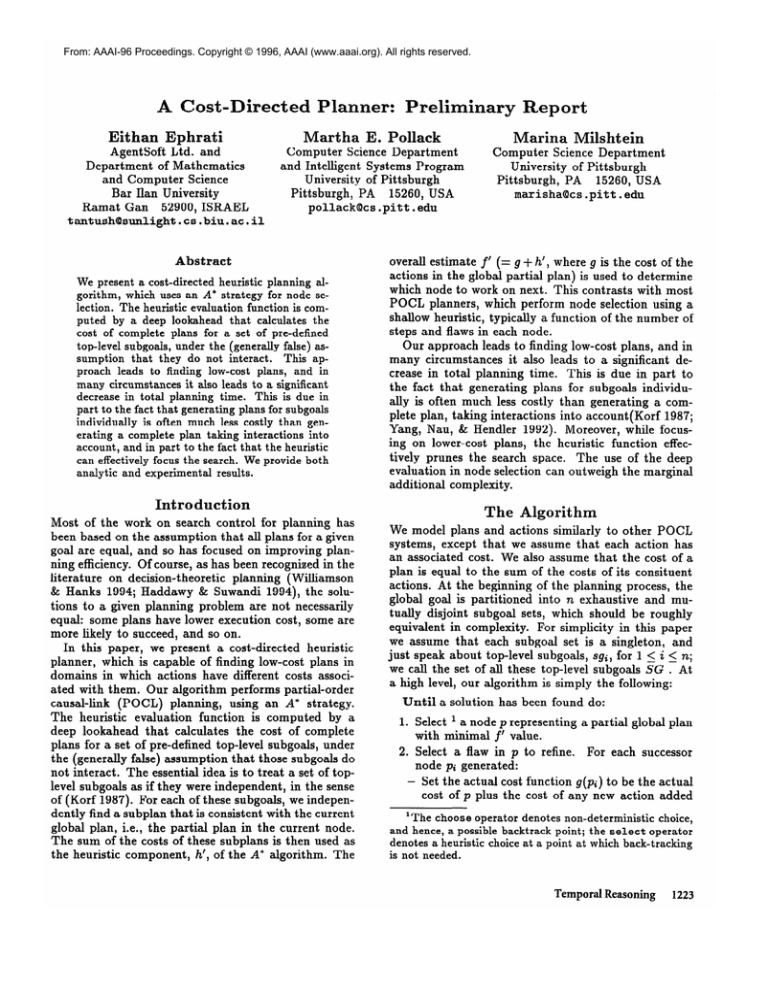
From: AAAI-96 Proceedings. Copyright © 1996, AAAI (www.aaai.org). All rights reserved.
A Cost-Directed
Eithan
Ephrati
AgentSoft Ltd. and
Department
of Mathematics
and Computer Science
Bar Ilan University
Ramat Gan
52900, ISRAEL
tantushQsnnlight.cs.biu.ac.il
Planner:
Martha
Preliminary Report
E. Pollack
Marina
Computer Science Department
and Intelligent Systems Program
University of Pittsburgh
Pittsburgh,
PA
15260, USA
pollack@cs.pitt.edu
Abstract
We present a cost-directed heuristic planning algorithm, which uses an A* strategy for node selection. The heuristic evaluation function is computed by a deep lookahead
that calculates
the
cost of complete
plans for a set of pre-defined
top-level subgoals, under the (generally false) assumption
that they do not interact.
This approach leads to finding low-cost
plans, and in
many circumstances
it also leads to a significant
decrease in total planning time.
This is due in
part to the fact that generating plans for subgoals
individually
is often much less costly than generating a complete
plan taking interactions
into
account, and in part to the fact that the heuristic
can effectively focus the search. We provide both
analytic and experimental
results.
overall estimate f’ (= g + h’, where g is the cost of the
actions in the global partial plan) is used to determine
which node to work on next. This contrasts with most
POCL planners, which perform node selection using a
shallow heuristic, typically a function of the number of
steps and flaws in each node.
Our approach leads to finding low-cost plans, and in
many circumstances
it also leads to a significant decrease in total planning time. This is due in part to
the fact that generating plans for subgoals individually is often much less costly than generating a complete plan, taking interactions into account(Korf
1987;
Yang, Nau, & Hendler 1992). Moreover, while focusing on lower-cost plans, the heuristic function effectively prunes the search space. The use of the deep
evaluation in node selection can outweigh the marginal
additional complexity.
Introduction
Most of the work on search control for planning has
been based on the assumption that all plans for a given
goal are equal, and so has focused on improving planning efficiency. Of course, as has been recognized in the
literature on decision-theoretic
planning (Williamson
& Hanks 1994; Haddawy & Suwandi 1994), the solutions to a given planning problem are not necessarily
equal: some plans have lower execution cost, some are
more likely to succeed, and so on.
In this paper, we present a cost-directed
heuristic
planner, which is capable of finding low-cost plans in
domains in which actions have different costs associated with them. Our algorithm performs partial-order
causal-link (POCL)
planning, using an A* strategy.
The heuristic evaluation function is computed by a
deep lookahead that calculates the cost of complete
plans for a set of pre-defined top-level subgoals, under
the (generally false) assumption that those subgoals do
not interact. The essential idea is to treat a set of toplevel subgoals as if they were independent, in the sense
of (Korf 1987). For each of these subgoals, we independently find a subplan that is consistent with the current
global plan, i.e., the partial plan in the current node.
The sum of the costs of these subplans is then used as
the heuristic component, h’, of the A* algorithm. The
Milsht ein
Computer Science Department
University of Pittsburgh
Pittsburgh,
PA
15260, USA
marisha@cs.pitt.edu
The Algorithm
We model plans and actions similarly to other POCL
systems, except that we assume that each action has
an associated cost. We also assume that the cost of a
plan is equal to the sum of the costs of its consituent
actions. At the beginning of the planning process, the
global goal is partitioned into n exhaustive and mutually disjoint subgoal sets, which should be roughly
equivalent in complexity.
For simplicity in this paper
we assume that each subgoal set is a singleton, and
just speak about top-level subgoals, sgi, for 1 5 i 5 n;
we call the set of all these top-level subgoals SG . At
a high level, our algorithm is simply the following:
Until a solution
has been found do:
1. Select ’ a node p representing
with minimal f’ value.
a partial global plan
2. Select a flaw in p to refine.
node pi generated:
For each successor
-
Set the actual cost function g(pi) to be the actual
cost of p plus the cost of any new action added
‘The choose operator denotes non-deterministic
choice,
and hence, a possible backtrack point; the select
operator
denotes a heuristic choice at a point at which back-tracking
is not needed.
Temporal Reasoning
1223
-
in the refinement.
(If the refinement is a threat
resolution, then g(pi) = g(p)).
Independently
generate
a complete
plan to
achieve each of the original subgoals sgi. Each
such subplan must be consistent with the partial global plan that pi represents, i.e., it must
be possible to incorporate
it into pi without violating any ordering or binding constraints.
Set
h’(pi) to the sum of the costs of the complete
subplans generated.
CostDirectedPlanSearch
While Q # 0 Select the first plan,
p=+S,L,0,23,A,I,SG,g,h’%,in
(Q)
Q
If A = 7 = 0 return p.
1.
[Termination]
2.
[Generate
Successors]
Let 0’ = I’ = b’= s’ = 0, and Select either:
(a)
An open condition
establisher:
i.
A formal definition of the algorithm is given in Figure 1. It relies on the following definitions, which are
similar to those of other POCL algorithms, except for
the inclusion of cost information for actions, and g and
h’ values, and subgoal partitions, for plans:
(d,Sd)
(in A of p), and
Choose an
[An Existing
Global Step]
s’ E S and b’, s.t.
e E
E(8’),
(e GsUb’ d), and ( 3’ < Sd) iS consistent
with 0,
ii. ;i
New step1
s-t. e E E(a),
9’ =
Fresh(a)
such that
a E A and
b’,
(e EBub’ d). -1
Let 0’ =
(b)
(3’ < L?d),I’ = ((S’,
d, ad)}.
An unresolved threat (st, se, d, Sd) E 7 of p, and Choose
Definition
1 (Operator
Schemata)
An
operator
either:
schema is a tupbe 4 T, V, P, E, B, c t where T is an
i.
[Demotion]
If (st < se) is consistent with 0,
action type, V is the list of free variables, P is the
let 0’ = ((at < se)}, or
set of preconditions
for the action, E is the set of efii. [PrOmOtiOd
If (st > sd) is consistent
with 0,
fects for the action, B is the set of binding constraints
let 0’ = ((St > Sd)}.
on the variables in V, and c is the cost.2 A copy of
If there is no possible establisher
or no way to resolve a
some action a with fresh variables will be denoted by
threat, then fail.
Fresh(a).
Given some action instance, s, we wibb re3. [Update Plan1 Let S’ = S U s’, L’ = L U I’, 0’ = 6 u 0’,
fer to its components by T(s), V(s), P(s), E(s), B(s),
8’ = 23 U b’, A’ = (d \ d) U P(s’).
Update 7 to include new
and c(s) .
threats.
Definition 2 (Plan) A plan is a tupbe + S, C, O,l3,
4. [Update Heuristic
Value]
&I,
SG,g, h’ +, where S is a set of the plan steps,
h’ = c 89* ESG SubPlan( 4 S’, L’, O’, B’, 0, sgi , 0 +).
i
C is a set of causal links on S, 0 is a set of ordering
constraints
on S, I3 is a set of bindings of variables
5. [Update Queue]
Merge the plan 4 S’, L’, O’, B’,d’,
SG, g, h’ F back into Q
in S, 4 is the set of open conditions, T is the set of
sorted by its g + h’ value.
unresolved threats, SG is the partition of A induced by
the initial partition of top-bevel subgoals, g is the accuFigure 1: The Search for a Global Plan
mulated cost of the plan so far, and h’ is the heuristic
estimate of the remaining cost.
There are two alternatives
for subplanning.
In
this paper, we assume that subplanning is done by a
The
initial
input
to
the
planner
is:
(4
fairly standard POCL algorithm, performing best first
{so < s,), 0, G, 0, SG, 0,O ~3, where SO
-lso, %03,@,
search. The subplanning process is invoked from the
is the dummy initial step, s, is the dummy final step,
main program (in Step 4) with its steps, links, and
G is the initial set of goals, and SG is a partition of G.
ordering and binding constraints
initialized to their
The algorithm also accesses an operator library A.
equivalents in the global plan. The set of open condiAs described above, the algorithm iteratively refines
tions is initialized to sgi, which consists of the open
nodes in the plan space until a complete plan has been
conditions associated
with the ith original subgoal:
generated. Its main difference from other POCL planany conditions from the original partition that remain
ners is its computation
of heuristic estimates of nodes.
open, plus any open conditions along paths to mem(See the boxed parts of the algorithm.)
The algorithm
bers of sgi.3 Essentially, when subplanning begins, it
maintains a queue of partial plans, sorted by f’; on
is as if it were already in the midst of planning, and
each iteration, it selects a node with minimal f’. Durhad found the global partial plan; it then forms a plan
ing refinement of that node, both the g and h’ compfor the set of open conditions associated with a topnents must be updated. Updating g is straightforward:
level subgoal. As a result, the plan for the subgoal will
whenever a new step is added to the plan, its cost is
be consistent with global plan. If a consistent subplan
added to the existing g value (Step 2(a)ii).
Updating
cannot be found, then the global plan is due to fail
h’ occurs in Step 4, in which subplans are generated
Subplanning can thus detect dead-end paths.
for each of the top-level subgoals.
2To maintain an evaluation function that tends to underestimate,
the cost of a step with uninstantiated
variables is heuristically
taken to be equivalent to the cost of
its minimal-cost grounded instance.
1224
Planning
3The main algorithm
tags each establisher
chosen in
step 2a with the top-level
goal(s)
that it supports.
We
_
_ __ _
--have omitted this detail from the Figure 1 to help improve
readibility.
The subplanning process keeps track of the actual
cost of the complete subplan found, and returns that
value to the main algorithm.
An alternative method for subplanning would be to
recursively call the global planning algorithm in Figure 1. This would be likely to further reduce the
amount of time spent on each node, because it would
amount to assuming independence not only among toplevel goals, but also among their subgoals, and their
subgoals’ subgoals, and so on. On the other hand, it
would lead to a less accurate heuristic estimate, and
thus might reduce the amount of pruning.
We are
conducting further experiments,
not reported in this
paper, to analyze this trade-off.
Complexity
We next analyze the complexity
of the cost-directed
planning algorithm.
Let b be the maximum branching
factor (number of possible refinements for each node),
and let d be the depth of search (number of refinements performed to generate a complete plan). Then,
as is well known, the worst-case complexity of planning search is O(@).
D uring each iteration of the costdirected algorithm, the most promising partial plan is
refined, and, for each possible refinement, a complete
subplan for each of the n elements of the original sub- q~=r
goal set (SG) is generated.
Let bi and di denote the breadth and depth of subplanning for the subgoal sg,,
to partition subgoals into sets of equal complexity.
For
domains for which this does not hold, it may still be
possible to use the cost-directed
planning algorithm,
but it would require invoking it recursively for subplanning, as described earlier.
We next consider the effect of pruning. The heuristic function in the A* search reduces the complexity of
the search from O(bd) to O(hd) where h is the heuristic branching factor (Korf 1987). Thus, for planning
problems with the properties mentioned above (balanced positive and negative interactions;
capable of
being paritioned into subgoals with roughly equal complexity) the overall complexity of the cost-directed
algorithm is O(hd x n x (i)t).
Cost-directed
search for
these problems will thus consume less time than a full
breadth-first planner as long as the following inequality
holds:4
n/(n
- 1)logh
5 logb - logn
Of course, no POCL planning algorithms actually use
breadth-first node selection; this inequality simply provides a baseline for theoretical comparison.
Later, we
provide experimental comparison of our algorithm with
best-first and branch-and-bound
control strategies.
Branching
Factor
= 3. nepch
= 9
d/n)) b**d .....
and let & = maxi bi, and let (ii = maxi di (1 < i < n).
Then the complexity of each subplanning step in the algorithm
if there
(Step 4) is O(n x (ii)‘;).
So in the worst case,
is no pruning, the overall complexity of the
search is O(bd x n x (ii)“).
Because & 5 b, and & 5 d,
the absolute worst case complexity is O(n x b2d).
However, for many planning domains, & and t& are
likely to be smaller than b and d. As noted by Korf
(Korf 1987, p.68), and by Yang et ab. (Yang, Nau,
& Hendler 1992), planning separately for n subgoals
will tend to reduce both b and d by a factor of n, i.e.,
Note that reduction in search
bi x i and di x $.
depth is due to the fact that, if there were no interactions among the subgoals, an overall plan would have
length equal to the sum of the lengths of the plans
Of course, positive interactions will
for the subgoals.
decrease the length of the overall plan, while negative
interactions
will increase it. We assume that the effects of negative interactions
will be at least as great
as the effects of positive interactions,
which appears to
be the case in many domains.
To obtain the maximum benefits of planning for individual subgoals separately, the subgoals must be of
roughly equal “complexity”
to one another.
If virtually all of the work of the top-level planning problem
is associated with a single subgoal, then planning separately for that subgoal will be almost as costly as
planning for the entire set of subgoals.
We therefore
also assume planning domains in which it is possible
.9s
Factor
Figure
2: Typical
(h/b)
Search Space Complexity
Figure 2 illustrates the inequality, comparing
the
complexity of cost-directed
search with a breadth-first
search (the level plane) as a function of the number of
We use a
subgoals (n) and the pruning effect (h/b).
planning problem with a branching factor of 3 and a
depth of 9 as an example. As the figure demonstrates,
there exists a region in which the cost-directed planner
performs better, namely the area in which the values of
the curve fall below the level plane. In general, the effectiveness of the cost-directed
planner increases with
the pruning effect and the number of subgoals being
used.
Note that this analysis assumes that the pruning factor is independent of the number of subgoal partitions.
4The complete derivation is given in (Ephrati,
& Miishtein
Pollack,
1996).
Temporal Reasoning
1225
In reality, the pruning factor is inversely related to the
number of subgoals-the
higher the number of subgoals that are being used, the less accurate the heuristic evaluation will tend to become. Thus, for a specific
problem, there exists some domain-dependent
decomposition into subgoals which will optimize the performance of cost-directed
search.
Caching
Subplans
In the algorithm as so far presented, all subplans are
recomputed on each iteration.
Often, however, previously generated subplans may remain compatible with
the current global partial plan, and it may thus make
sense to cache subplans, and to check whether they are
still consistent before attempting
to regenerate them.
An added advantage of caching the subplans is that the
top-level planner can then at tempt to re-use subplan
steps; this helps maintain the accuracy of the heuristic
evaluation function.
We therefore modify the original algorithm by attaching to each global plan a set of subplans (P =
instead of just a partition of subgoals.
-pl,- - .,EJ)
Then, following each refinement of the global plan, the
set of subplans is checked for consistency
(with the
newly refined global plan) and only the subplans that
are incompatible
are regenerated.
Although caching subplans may significantly reduce
the number of subplans generated, it can also increase
space complexity;
details of this trade-off are given in
(Ephrati, Pollack, & Milshtein 1996). In all the experiments reported below, subplans were cached.
Experimental
Results
The complexity
analysis above demonstrates
the potential advantages of our approach.
To verify the advantages in practice, we conducted a series of experiments comparing the cost-directed search with caching
against the standard UCPOP algorithm with the builtin default search control, and againt UCPOP with a
control mechanism that finds the minimal cost plan
using branch-and-bound
over action costs (henceforth
called B&B).
Effects
of Subgoal
Independence
In the first experiment, our aim was to study the performance of the algorithms in domains in which the
top-level subgoals had different levels of dependence.
We therefore constructed three synthetic operator sets
in the style of (Barrett & Weld 1994):
l
Independent Subgoals: Barrett and Weld’s BjD”Sn
(p. 86). sn means that it takes n steps to achieve
Do means that the delete
each top-level subgoal.
set of each operators is empty, so all the top-level
subgoals are independent.
@j means that there are j
different operators to achieve each precondition.
1226
Planning
Heavily Dependent Subgoals:
Barrett
and Weld’s
6j D”S” * (p. 93). As above, there are j different operators to achieve each precondition,
and each toplevel subgoal requires an n-step plan. Dm* refers to
a pattern of interaction among the operators.
There
is a single operator that must end up in the middle
of the plan, because it deletes all the preconditions
of the operators in stages 1 through k for some k, as
well as all the effects of the operators in stages k + 1
through n. In addition, for each stage, the operators for the ith subgoal delete all the preconditions
of the same-stage operators for subgoals j < i. Consequently, there is only a single valid linearization
of the overall plan; the dependency among top-level
subgoals is heavy.
Moderately Dependent Subplans: A variant of Barrett and Weld’s 6jDmSn
(p. 91). Here again there
are j different operators to achieve each precondition, and each top-level subgoal requires an n-step
plan. In addition, the union of delete lists of the
k + 1st stage operators for each subgoal sgi delete
abbof the preconditions for the kth stage operators
for all other sgj, j # i. Because these preconditions
are partitioned among the alternative kth stage operators, there are multiple valid linearizations of the
overall plan. Although the top-level subgoals interact, the dependency isn’t as tight, given the multiple
possible solutions.
One thing to note is that the individual subplanning
tasks in our experiments
are relatively easy: the interactions occur among the subplans for diRerent subgoals. Of course, this means that planning for UCPOP
and B&B is comparatively
easy as well. Further experiments are being conducted using operator sets with
interactions within each subplan.
For the first experiment,
we used problems with 4
top-level subgoals, and built the operator sets so that
each top-level subgoal required a plan of length 3 (i.e.,
we used the S3 version of each of the operator sets).
The actions were randomly assigned costs between 1
and 10. Finally, we varied the number of operators
achieving each goal (the j in 6j) to achieve actual
branching factors, as measured by UCPOP, of about
3 for the case of independent
subgoals, about 2 for
medium dependent subgoals, and about 1.5 for heavily
dependent subgoals. The results are shown in Table 1,
which lists
o the number of nodes generated and the number of
nodes visited (these numbers are separated by an
arrow in the tables);
* the CPU time spent in planning.5
5For certain problems that required a great deal of memory, the garbage collection process caused Lisp to crash, reporting an internal error. Schubert and Gerevini (Schubert
& Gerevini 1995) encountered
the same problem in their
UCPOP-based
experiments,
with problems that required a
a the cost of the plans generated
(sum of action costs).
same costs, then no pruning will result from a strategy based on cost comparison, and the space taken by
caching subplans will be enormous.
As can be seen in the table, COST performed best in
all cases, not only examining significantly fewer nodes,
but taking an order of magnitude less time to find a
solution than B&B. Not surprisingly, COST’s advantage increases with the degree of independence among
the subgoals: the greater the degree of independence
among the subplans, the more accurate
is COST’s
heuristic function, and thus the more effective its pruning. However, even in the case of heavy dependence
among top-level subgoals, COST performs quite well.
Dependency
Independent
Medium
Medium
Nodes
Time
failure
39927.89
-
2183.21
126.13
37
37
40348.54
9185.691
-
613.54
37
B&B
COST
35806 +
60 +
UCPOP
B&B
12900
22
failure
214 failures
UCPOP
B&B
-+ 5198 (succ.
309 4 146
*
failure
COST
-+ 17567
780 +
(sncc.
444
Degree
-
3834.517
37
only)
Table 1: Varying dependency (4 medium uniform subb x 2 for
goals, 3 Steps each, b M 3 for independent,
medium, b x 1.5 for heavy)
of Uniformity
The next thing we varied was the uniformity of action
cost: see Tables 2 and 3. For this experiment, we used
the independent subgoal operator set described above,
with 3 steps to achieve each subgoal, and an actual
branching factor of approximately
3. The experiment
in Table 2 involved 6 top-level subgoals, while the experiment in Table 3 involved 4. In both experiments,
we varied the distribution of action costs: in the highly
uniform environment,
all actions were assigned a cost
of 1; in the medium uniform environment,
they were
randomly assigned a cost between 1 and 10; in the
the low uniform environments, they were randomly assigned a cost between 1 and 100.
Both UCPOP and B&B failed to find a solution for
problems with 6, and even with 4 independent subgoals
within the 150,000 nodes-generated
limit.
In highly
uniform domains, i.e., those in which alI actions had
the same cost, our cost-directed
algorithm fared no
better:
it also failed, although by exceeding memory
limits. This is not surprising:
if all actions have the
lot of memory. We do not report results for these problems,
but instead put an asterisk (*) in the time column.
Also,
in some cases, B&B succeeded- on some operator sets, and
failed on others.
For those cases, we report the average
time taken on all runs (which will be an underestimate,
as the failed run were terminated
after 150,000 generated
nodes).
We report the number of nodes only for the successful cases. Finally, we do not report the costs found in
these cases, because the high-cost
plans are typically
the
cases that fail. In no case did B&B find a lower-cost
plan
than COST.
Time
cost
28980.45
26165.37
210.44
2167
UCPOP
failure
36519.96
-
failure
134 + 44
26952.57
407.84
54
failure
failure
failure
14986.58
27304.23
*
-
UCPOP
B&B
COST
(6 independent
subgoals,
cost
Planner
Nodes
Time
Low
UCPOP
B&B
COST
failure
65000 + 23158
50 + 18
14617.54
12708.66
98.22
1761
1761
Medium
UCPOP
B&B
COST
failure
35806 + 12900
60 + 22
39927.89
2183.21
126.13
37
37
High
UCPOP
B&B
COST
failure
failure
failure
14528.38
26988.26
*
-
-
12727.83
Nodes
failure
failure
70 + 26
Table 2: Varying Uniformity
3 Steps each, b x 3)
only)
214 failures
42978
1 Cost
Planner
UCPOP
B&B
COST
B&B
COST
High
Planner
COST
Effects
Low
UCPOP
14827
Heavy
Degree
Table 3: Varying Uniformity
3 Steps each, b x 3)
(4 independent
subgoals,
However, when the environments
become less uniform, we see the payoff in the cost-directed
approach.
For low uniform environments and a planning problem
with 6 subgoals (Table 2), the cost-directed
planner
finds plans by generating less than 70 nodes, taking
about 3.5 minutes-while
UCPOP and B&B failed, after generating 150,000 nodes, and taking over 7 hours.
Even with medium uniformity, cost-directed
planning
succeeds quickly, while the other two approaches fail.
Similar results are observed for the smaller (4 subgoal)
problem (Table 3).
Note again that these are very easy problems, given
the independence of the top-level subgoals. Indeed, the
optimal strategy would have been to plan completely
separately for each subgoal, and then simply concatenate the resulting plans. However, one may not know,
in general, whether a set of subgoals is independent,
prior to performing planning. The cost-directed search
performs very well, while maintaining a general, POCL
strategy that is applicable to interacting, as well as independent, goals.
Other
Factors
Effecting
Planning
Several other key factors that are known to effect the
efficiency of planning are the average branching factor,
the length of the plan, and the number of top-level
subgoals.
We have conducted,
and are continuing to
conduct, experiments that vary each of these factors;
so far, our results demonstrate that in a wide range of
environments, the COST algorithm performs very well,
finding low-cost plans in less time than either UCPOP
or B&B (Ephrati, Pollack, & Milshtein 1996).
Temporal Reasoning
1227
Related
Research
Prior work on plan merging (Fousler, Li, & Yang 1992;
Yang, Nau, & Hendler 1992) has studied the problem
of forming plans for subgoals independently and then
merging them back together.
Although similarly motivated by the speed-up one gets from attending to
subgoals individually, our work differs in performing
complete planning using a POCL-style
algorithm, as
opposed to using separate plan merging procedures.
The idea of using information
about plan quality
during plan generation
dates back to (Feldman
&
Sproull 1977); more recent work on this topic has involved the introduction
of decision-theoretic
notions
(Haddawy & Suwandi 1994). Perez studied the problem of enabling a system to learn ways to improve the
quality of the plans it generates (Perez 1995). Particularly relevant is Williamson’s work on the PYRRHUS
system (Williamson
& Hanks 1994), which uses plan
quality information
to find an optimal plan. It performs standard POCL planning, but does not terminate with the first complete plan. Instead, it computes
the plans’s utility, prunes from the seach space any partial plans that are guaranteed to have lower utility, and
then resumes execution. The process terminates when
no partial plans remain, at which point PYRRHUS
is
guaranteed to have found an optimal plan. What is interesting about PYRRHUS
from the perspective of the
current paper is that, although one might expect that
PYRRHUS
would take significantly longer to find an
optimal plan than to find an arbitrary plan, in fact, in
many circumstances
it does not. The information provided by the utility model results in enough pruning
of the search space to outweigh the additional costs of
seeking an optimal solution. This result, although obtained in a different framework from our own, bears a
strong similarity to our main conclusion, which is that
the pruning that results from attending to plan quality
can outweigh the cost of computing plan quality.
Conclusions
We have presented an efficient cost-directed
planning
algorithm.
The key idea underlying it is to replace a
shallow, syntactic heuristic for node selection in POCL
planning with an approximate,
full-depth lookahead
that computes complete subplans for a set of top-level
subgoals, under the assumption that these subgoals are
independent.
Our analytical and experimental results
demonstrate that in addition to finding low-cost plans,
the algorithm can significantly improve planning time
The performance of the algoin many circumstances.
rithm is dependent upon the possibility of decomposing the global goal into subgoal sets that are relatively
(though not necessarily completely) independent, and
that are roughly equivalent in complexity to one another.
The experiments we presented in this paper support
the main hypothesis, but are by no means complete.
We are continuing our experimentation,
in particular,
1228
Planning
studying domains that involve a greater degree of interaction within each subplan.
In addition,
we are
investigating
the trade-off between using a complete
POCL planner for subplanning, as in the experiments
reported here, and recursively calling the main algorithm for subplanning. Finally, we are developing techniques to make the cost-directed
search admissible.
Acknowledgments
This
work has been supported
the Rome Laboratory
of the Air Force Material
and the Advanced
Research
Projects
Agency
F30602-93-C-0038),
tract
tor’s
by the Office
Award
of Naval Research
and by an NSF Young
N00014-95-l-1161)
by
Command
(Contract
(Con-
Investiga-
(IRS9258392).
References
Barrett, A., and Weld, D. 1994. Partial-order
planning: Evaluating possible efficiency gains. Artificial
Intelligence 67( 1):71-112.
Ephrati, E.; Pollack, M. E.; and Milshtein, M. 1996.
A cost-directed
planner. Technical Report, Dept. of
Computer Science, Univ. of Pittsburgh,
in preparation.
Feldman, J. A., and Sproull, R. F. 1977. Decision theory and artificial intelligence II: The hungry monkey.
Cognitive Science 1:158-192.
Fousler, D.; Li, M.; and Yang,
algorithms for plan merging.
57:143-181.
Q. 1992.
Arti$ciab
Theory and
Intelligence
Haddawy, P., and Suwandi, M.
1994.
Decisiontheoretic refinement planning using inheritance
abstraction.
In Proceedings of the Second International
Conference
on AI Planning Systems, 266-271.
Korf, R. E. 1987. Planning as search: A quantitative
approach. Artificial Intelligence 33:65-88.
Perez,
M. A.
1995.
Improving
search control
knoweldge to improve plan quality.
Technical Report CMU-CS-95-175,
Dept. of Computer
Science,
Carnegie Mellon University. Ph.D. Dissertation.
Schubert, L., and Gerevini, A. 1996.
Accelerating
partial order planners by improving plan and goal
choices. Technical Report 96-607, Univ. of Rochester
Dept. of Computer Science.
Williamson, M., and Hanks, S. 1994. Optimal planning with a goal-directed utility model. In Proceedings
of the Second International
Conference
on Artificial
Intelligence Planning Systems, 176-181.
Yang, Q.; Nau, D. S.; and Hendler, J. 1992. Merging separately generated plans with restricted interactions. Computational
Intelligence 8(2):648-676.
